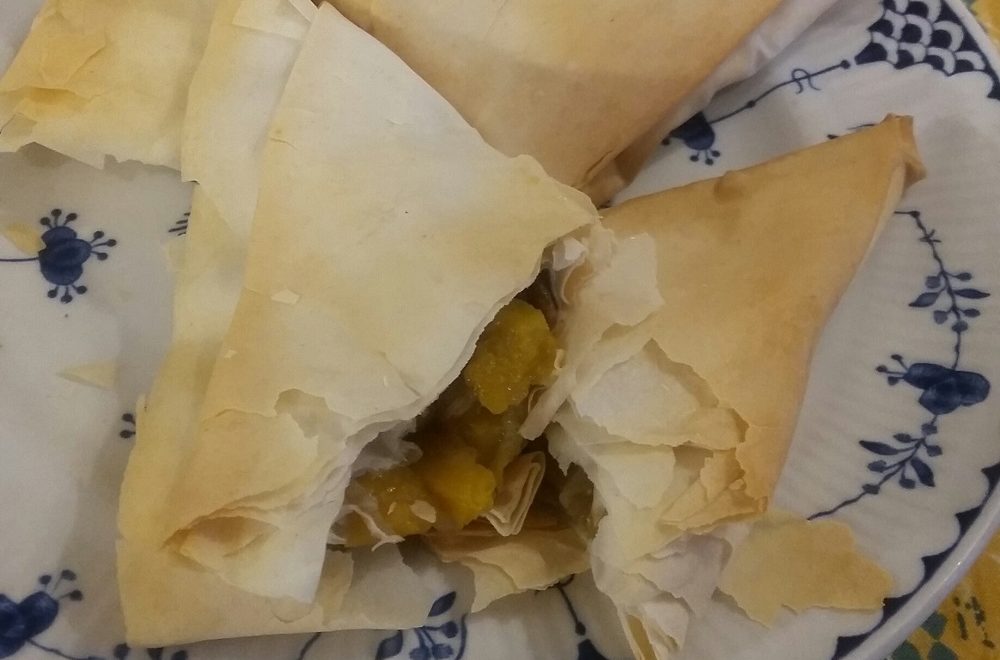Easier than you might think – and they can be made ahead of time! These little parcels are crisp on the outside and deliciously soft and flavoured on the inside. Perfect finger-food packed full of goodness.
Serves: makes 12 samosas
Dietary: suitable for vegans, vegetarians, dairy-free, nut-free
Preparation time: 40 minutes cooking, 15 minutes forming samosas
Cooking time: 15 -18 minutes
INGREDIENTS
450 g pumpkin, peeled, chopped into small dice
1 Tbsp garam masala/ground cumin/coriander – adjust to taste
Seasoning, optional
1 medium onion, finely diced
4 tsp sunflower oil
2 Tbsp pumpkin seeds, preferably toasted
12 sheets fresh filo pastry (about 250g)
2 Tbsp olive oil/ sunflower oil for brushing
METHOD
- Sauté onion, garlic & pumpkin with the spices of your choice (adjust to suit your taste) for about 10 minutes until the pumpkin and onion are soft.
- Turn off the heat, and stir in pumpkin seeds.
- Pre-heat oven to 180ºC and lightly grease a baking sheet & dampen a tea towel.
- Layout filo pastry.
- Cut pastry sheets into half length-wise (into long rectangles). Working with a double layer, place 2 Tbsp of filling in one corner and fold into a triangle. cover ‘non-working’ sheets in a damp tea towel to prevent them from drying out
- Fold over the long edges into a little border to give a nice firm edge. Place the filling mixture in one corner and fold firmly to form a plump triangle. Brush with a little oil occasionally as you continue folding into a samosa-triangle shape.
- Place on greased baking sheet.
- Repeat for all 12 samosas.
- Bake for 15-18 minutes.
This recipe has been donated by Catherine McNeill
NUTRITION INFORMATION
Per serving (1 samosa):
Total calories: 120 kcal
Fat: 4.8 g
Saturated Fat: 0.7 g
Carbohydrate: 16 g
Total sugar: 2.8 g
Fibre: 1.1 g
Protein: 2.9 g
Salt: 0.2 g
NUTRITION FACTS
- Traditionally, ghee (clarified butter) would have been used to make samosas. We have used no-nut vegetable oil, e.g. sunflower oil) to reduce saturated fat.
- Beware that vegetable oils can contain groundnut (peanuts) and may not be safe for those who suffer from peanut allergies.
- These samosas are baked rather than deep-fried, reducing their total fat content.
- Pumpkin seeds and certain oils such as rapeseed are a source of omega-3 fats, important for children’s brain and eye development.
- Pumpkins and pumpkin seeds are good sources of vitamin E.
VARIATIONS
- Fresh herbs (e.g. coriander or parsley leaves) could be stirred in just before making the samosas to vary the flavour.
- Use butternut squash, carrot, sweet potato – or a mixture
- Peas or sweetcorn could be used to ‘top-up’ the mixture if you don’t have quite enough pumpkin flesh.
- Try different seeds or a combination. However, avoid sesame seeds as many people allergic to nuts may also be allergic to sesame seeds.
- If you have leftover mashed potatoes/lentils/rice, use them up in the stuffing mixture.
- Complete up to end of stage 2. The mixture can be cooled and stored overnight before turning into samosas.
© 2021 The Caroline Walker Trust

